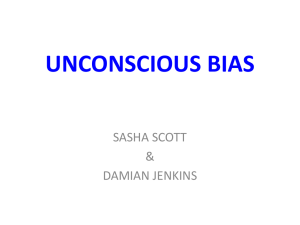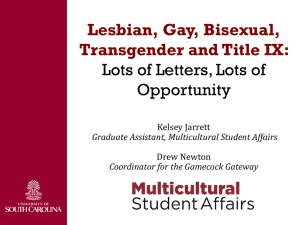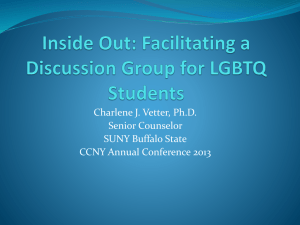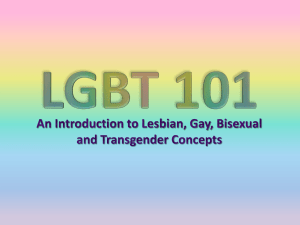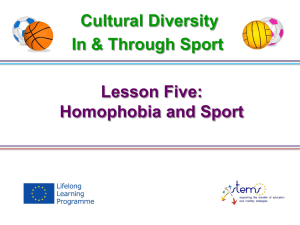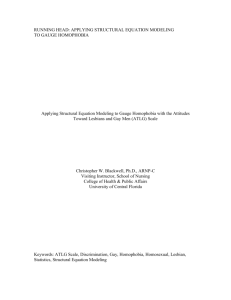An Examination of Homophobia and Social Work Practice
advertisement
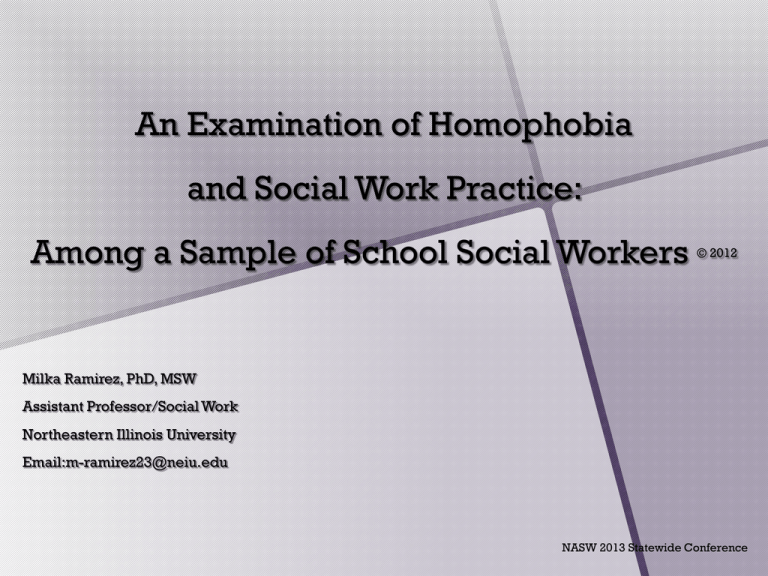
An Examination of Homophobia and Social Work Practice: Among a Sample of School Social Workers © 2012 Milka Ramirez, PhD, MSW Assistant Professor/Social Work Northeastern Illinois University Email:m-ramirez23@neiu.edu NASW 2013 Statewide Conference OUTLINE Overview of study Rational of the study Literature review Theoretical framework Research questions Methodology Findings Implications IN MEMORY OF LAWRENCE “LARRY” KING On Feb. 12, 2008 Lawrence “Larry” King was in the school’s computer lab with 24 other students. A classmate walked up to Larry, and shot Larry in the back of the head. Larry died on February 15, 2008, at the age of 14. The investigation into Larry’s murder revealed that Larry was shot by Brandon McInerney, age 14, due to Larry’s sexual orientation and sexual expression. STUDY OVERVIEW The study addresses a gap in knowledge about homophobia among school social workers (SSW) and SSW’s practice with lesbian, gay, bisexual, transgender (LGBT) youth. In this study homophobia is conceptually defined as the broad range of negative attitudes and beliefs about LGBT populations that may lead to a reduction of effective mental health services for LGBT individuals. 5,10,11,17 THE STUDY EXAMINED The current degree of homophobia among school social workers, and relationship between homophobia and use of gay affirmative practice among school social workers. As well as, school climate’s moderating effect on homophobia and use of gay affirmative practice in school settings. STUDY RATIONAL Empirical evidence suggest that LGBT youth are one of the most vulnerable school populations in contemporary society.5,8,15,16 Research also indicates that ideological contradictions may exist between our professions’ espoused beliefs and actual practice behavior with LGBT populations.4,7,10,11,13 Yet there is a gap in knowledge about school social workers attitudes and beliefs regarding LGBT individuals and use of gay affirmative practice.10,11,12 Seen Violence Submerged Violence Institutional Violence Cultural Violence Van Soest & Bryant (1995) Theoretical Framework Bandura(1977) Social Learning Theory Observation Modeling Imitation Hofstede(2001) Organizational Theory Power-Individualism-Collectivism Organizational Justice: Distributive-Interactional Justice What is the degree of homophobia among School Social Workers? Does it vary by demographic variables that include religiosity, age, sexual orientation, personal contact with LGBT individuals, education and training about LGBT individuals? What is the degree of homophobia among School Social Workers? Does it vary by demographic variables that include religiosity, age, sexual orientation, personal contact with LGBT individuals, education and training about LGBT individuals? To what extent do School Social Workers engage in gay affirmative practice with LGBT students? Does it vary by demographic variables that include religiosity, age, sexual orientation, personal contact with LGBT individuals, education and training about LGBT individuals? Is the association between homophobia among School Social Workers and use of gay affirmative practice moderated by school climate? Does it vary by demographic variables that include religiosity, age, sexual orientation, personal contact with LGBT individuals, education and training about LGBT individuals? Methodology National on-line confidential survey across 42 states Purposeful sampling (N=283) • School Social Work Association of America (SSWAA) • American Council for School Social Work (ACSSW) • Affiliates of SWAA and CSSW CONCEPTUAL MODEL Social Learning Theory Control Variables: Organizational Theory Age Sexual orientation Education Training School Climate Personal contact Religiosity Homophobia Gay Af irmative Practice The sample consisted of 43 year old, White (74%), heterosexual (85.3%), females (84.2%), identified as Catholic (52%), with a Master’s degree (81%), practicing in urban settings with an average of 11 years of practice experience (44%). Age (R)21=69 N=272 Homophobia, Gay Affirmative Practice, Personal Contact • Non-homophobic views(n=236) (M)66.86 • Gay affirmative practice(n=236) (M) 61.62 65% Personal contact (1-10) Friend 55.8% Family 23% • Homophobia and PC(n=236) personal contacts with LGBT individuals(r =.37*; p< .05) • Gay Affirmative Practice & PC(n=236) personal contacts with LGBT individuals(r =.41**; p< .01) • Personal contact(n=236) Professional development(r=29**;p.<.01) Homophobia, Gay Affirmative Practice, Education, Training • Homophobia(n=236) personal contact (r=.37**;p.<.01) self-directed learning(r = .33**; p< .01) professional development (r=15*;p<.05) percentage of time master’s education (r=.12*;p.<.05) class instruction master’s education (r=.16*; p.< .05) • Gay Affirmative Practice(n=236) self-directed learning(r = 38**; p < .01) percentage of time master’s education (r=16*; p.< .05) class instruction master’s education (r = 16*; p.< .05) professional development (r=.25**;p.<.01) supervision/case consultation (r=21*;p.<.05 Homophobia, Gay Affirmative Practice, Religiosity • Hodge’s (1972) Intrinsic Religious Motivation Scale • Religious affiliation • Frequency of attendance • Homophobia & religiosity scale(n=236) (r=-.13**;p.<.01) • Homophobia & attendance of religious services(n=236) (r= -.24**;p.<.01) • Gay Affirmative Practice & religiosity scale(n=236) (r= -.16**;p.<.01) • Gay Affirmative Practice & attendance of religious services(n=236) (r= -.27**;p.01) School Climate Administrative support-LGBT services in school (n=187) Yes=68%: No=32% Hear anti-gay epithets like; “That’s so gay” (n=255) • Yes=57%: No=43% • “Faggot or Dyke”(n=255) Yes=29%: No=71% GSA or club/organization (n=248) Yes=22%: No=78% School safe for gay and lesbian faculty/staff (n=202) Yes=45%: No=55% Safe school policy to protect faculty/staff (n=144) Yes=66%: No=34% School social work practitioners currently hold non-homophobic views and provide gay affirmative practice School social work practitioners are uniquely positioned to intervene at the school’s mezzo level to impact school climate School social work practitioners actively seeking knowledge about LGBT populations, and may benefit from educational content, training, supervision and case consultation about LGBT populations There exist contradictions in CSWE’s call for LGBT education content and social work education's response, and CSWE’s religious exception There is a need for school policy to address safe school climate for LGBT youth, faculty and staff There exist a need to develop social work curriculum to address LGBT populations in higher education and K-12 educational settings There is a need to examine geographic associations, religiosity homophobia and gay affirmative practice There is a need to develop standardized and accessible measures for school climate that specifically examines homophobia and gay affirmative practice in school settings There is a need to develop cultural competency services for LGBT youth in school settings, and identify where school practitioners obtain their knowledge and practice information about LGBT youth References 1. Adam, B. (1995). The rise of a gay and lesbian movement. Boston, MA: G.K. Hall. 2. Anderson, J. F., Dyson, L., Brooks, W. (2002). Preventing hate crime and profiling hate crime offenders. The Western Journal of Black Studies, 26(3), 140-149. 3. Allen-Meares, P., (2007). Social work services in schools(5thed). Boston: Allyn and Bacon. 4. Anderson, S.C. and Holliday, M. (2007). How heterosexism plagues practitioners in services for lesbians and their families: An exploratory study. Journal of Gay and Lesbian Social Services, 19(2), 81-100. 5. Appleby, G.A., & Anastas, J.W. (1998). Not just a passing phase: Social work with gay, lesbian and bisexual people. Columbia University Press: New York. 6. Bandura, A. (1977). Social learning theory. Prentice Hall: N.J. 7. Berkman, C., & Zinberg, G. (1997). Homophobia and heterosexism in social workers. Social Work, 42,319-332. 8. Bochenek, M., and Brown, W.A. (2001). Hatred in the hallways: violence and discrimination against lesbian, gay, bisexual and transgender students in U.S. schools. Human Rights Watch, New York: NY. 9. Boswell, J. (1994). Same-sex unions in premodern Europe. New York: Villard Books References 10. Crisp, C. (2002). Beyond homophobia: Development and validation of the Gay Affirmative Practice Scale(GAP). Dissertation Abstracts International, 64, 074. (UMI No. 3099441) 11. Crisp, C. (2006). The gay affirmative practice scale (GAP): a new measure for assessing cultural competence with gay and lesbian clients, Social Work, 51(2) 115-126. 12. Davies, D. (1996). Towards a model of gay affirmative therapy: In D. Davies & C. Neal (Eds.), Pink therapy: A guide for counselors and therapist working with lesbian, gay and bisexual clients. Philadelphia: Open University Press 13. DeCrescenzo, T. (1984). Homophobia: A study of the attitudes of mental health professionals toward homosexuality. In R. Schoenberg, R. S. Golddberg, & A.A. Shod (Eds.), With compassion toward some: Homosexuality and social work in America (pp. 115-136). New York: Harrington Park Press. 14. D’Emilio, J., and Freedman, E.B. (1988, 1997). Intimate Matters: A History of Sexuality in America. (2ndEdison).Chicago and London:The University of Chicago Press. 15. Glisson, C. and James, L.R. (2002). The cross-level effects of culture and climate in human service teams. Journal of Organizational Behavior, 23, 767-794. References 16. Glisson, C. and Green, P. (2006). The effects of organizational culture and climate on the access to mental health care in child welfare and juvenile justice systems, Journal of Organizational Behavior, 33(4), 433-448. 17. Herek, G. (1984). Beyond “homophobia”: A social psychological consequences of the social construction of gender and sexuality. American Behavioral Scientist, 29, 563-577. 18. Herek, G. and Berrill, K. (1992). Hate Crimes: Confronting violence against lesbians and gay men. Newbury Park London: Sage publications. 19. Herek, G. and Berrill, K. (1992). Hate Crimes: Confronting violence against lesbians and gay men. Newbury Park London: Sage publications. 20. Herek, G. (2000). The psychology of sexual prejudice. American Psychological Association, 9(1). 21. Herek, G. (2009).Sexual stigma and sexual prejudice in the United States: A conceptual framework. In D.A. Hope (Ed.). Contemporary Perspectives on Lesbian, Gay and Bisexual Identities: The 54thNebraska Symposium on Motivation: New York: Springer. 22. Krieglstein, M. (2002). Heterosexism and social workers: An ethical issue. Journal of human behavior in the social environment, 8(2/3). 75-91. 23. Weinberg, G. (1972, 1993). Society and the healthy homosexual. New York: St. Martin’s Press.




